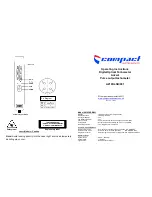
IV
2.1.2 Spectroquant
®
Reagent Tests
The principle behind the reagent tests is that the
reagents necessary for the colour reaction are com-
bined in the form of liquid concentrates or solid-
substance mixtures. In these tests, a few drops of the
respective reagent concentrate are added to, for
example, 5 ml of sample. This means that there is no
need to dilute the sample, which in turn enhances the
sensitivity of the detection. The making up of a
sample in a volumetric flask to a defined volume usual
in conventional photometry can be dispensed with.
2. Photometric Test Kits
The intensity of the colour of a solution, measured as
the absorbance, is proportional to the concentration
of the respective analyte only within a specific range.
This measuring range (effective range) is electro-
nically stored in the photometers for each individual
test kit (see overview table in section 1.3).
Below the specified measuring range, either a
different cell or else another procedure must be
used. The
lower limit of the measuring range
either
takes the form of nonlinearity of the calibration curve,
as shown in the figure below, or else is given by the
limit of detection. The
limit of detection
of a given
analytical method is the lowest concentration that
differs from the zero concentration with a defined
probability (e.g. 99%).
The
upper limit of the measuring range
is charac-
terized by there no longer being any linear correlation
between analyte concentration and absorbance. In
such a case the sample must be diluted accordingly
so that it lies ideally in the middle of the effective
range (least-error measurement).
In photometry it is conventional practice to measure
against the reagent blank value. Here the analysis is
carried out “blind”, i.e. without any analyte added.
Instead of the sample volume, the corresponding
quantity of distilled or DI water is used. This
reagent
blank value is already electronically stored
in the
system photometers, meaning that a separate mea-
surement is not necessary. It is possible, however, to
enhance the accuracy of the determination at the
measuring-range limit by measuring against a self-
prepared reagent blank solution (for adjustment see
Function description, “Blank-value correction”).
There are, however, also cases in which the colour
intensity of the solution and thus the absorbance
drop off again at
very high analyte concentrations
.
These exemplary cases are listed in the table below.
The values indicated in the display are correct up to
the concentrations specified in the third column, and
false measuring values are obtained above these
concentrations. In such a case it is necessary to con-
duct a plausibility check by running preliminary tests
using test strips or dilution.
2.2 Notes for Practical Use
2.2.1 Measuring Range
Concentration
Abs
orbance
Art.
Method
Correct indica-
Colour change
tion of result up
to sample conc.
14752
Ammonium
25 mg/l
turquoise instead of green
14558
CT Ammonium
250 mg/l
turquoise instead of green
14544
CT Ammonium
100 mg/l
turquoise instead of green
14559
CT Ammonium
5000 mg/l
turquoise instead of green
14828
Chlorine
30 mg/l
yellow instead of red
14557
CT Fluoride
4 mg/l
brownish-yellow instead of violet
14553
CT Copper
25 mg/l
light blue/turquoise instead of blue
14767
Copper
25 mg/l
light blue/turquoise instead of blue
14551
CT Phenol
100 mg/l
weakening of colour
14831
Silver
5 mg/l
no change (flocculation)
Release 05/04
Содержание PhotoLab Spektral
Страница 2: ......
Страница 31: ...Edition date 06 00 Order no ba 41111e04 Functional description Edition date 04 2004 Order no ba41111e08...
Страница 32: ......
Страница 38: ...8 List of contents...
Страница 128: ...98 13 User defined methods...
Страница 132: ...102 14 Photometer setup...
Страница 140: ...110 16 RS 232 C interface...
Страница 144: ...114 18 Exchanging the Memory Card...
Страница 152: ...122 21 Appendix 21 1 Menu structure of the setup menu...
Страница 153: ...123 21 Appendix...
Страница 154: ...124 21 Appendix...
Страница 160: ......
Страница 161: ......







































